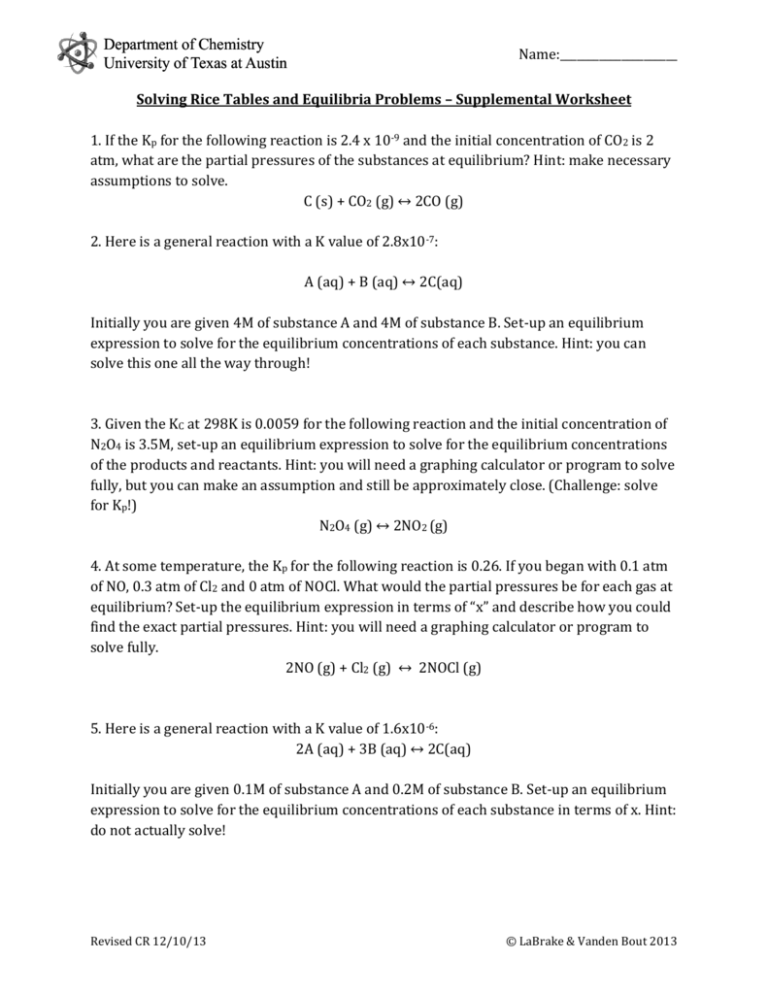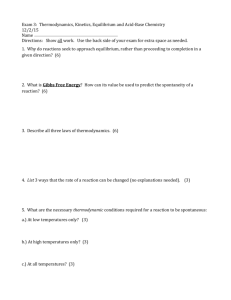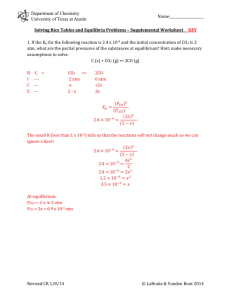RICE Tables and Equilibrium Problems
advertisement

Department of Chemistry University of Texas at Austin Name:_____________________ Solving Rice Tables and Equilibria Problems – Supplemental Worksheet 1. If the Kp for the following reaction is 2.4 x 10-9 and the initial concentration of CO2 is 2 atm, what are the partial pressures of the substances at equilibrium? Hint: make necessary assumptions to solve. C (s) + CO2 (g) ↔ 2CO (g) 2. Here is a general reaction with a K value of 2.8x10-7: A (aq) + B (aq) ↔ 2C(aq) Initially you are given 4M of substance A and 4M of substance B. Set-up an equilibrium expression to solve for the equilibrium concentrations of each substance. Hint: you can solve this one all the way through! 3. Given the KC at 298K is 0.0059 for the following reaction and the initial concentration of N2O4 is 3.5M, set-up an equilibrium expression to solve for the equilibrium concentrations of the products and reactants. Hint: you will need a graphing calculator or program to solve fully, but you can make an assumption and still be approximately close. (Challenge: solve for Kp!) N2O4 (g) ↔ 2NO2 (g) 4. At some temperature, the Kp for the following reaction is 0.26. If you began with 0.1 atm of NO, 0.3 atm of Cl2 and 0 atm of NOCl. What would the partial pressures be for each gas at equilibrium? Set-up the equilibrium expression in terms of “x” and describe how you could find the exact partial pressures. Hint: you will need a graphing calculator or program to solve fully. 2NO (g) + Cl2 (g) ↔ 2NOCl (g) 5. Here is a general reaction with a K value of 1.6x10-6: 2A (aq) + 3B (aq) ↔ 2C(aq) Initially you are given 0.1M of substance A and 0.2M of substance B. Set-up an equilibrium expression to solve for the equilibrium concentrations of each substance in terms of x. Hint: do not actually solve! Revised CR 12/10/13 © LaBrake & Vanden Bout 2013 Department of Chemistry University of Texas at Austin Name:_____________________ 6. Here is a general reaction with a K value of 144: A2 (aq) + B2 (aq) ↔ 2C (aq) If the initial concentrations for A2 and B2 are 0.7 M, find the final concentration of C. Hint: make necessary assumptions to solve. 7. Given that the molar solubility of PbSO4 is 1.59 x 10-4 M, what is the Ksp of PbSO4? 8. In the previous problem, if we had placed the PbSO4 solid into a solution containing 0.5M (NH4)2SO4 what concentration of Pb2+ ion will be in solution at equilibrium? You will need a calculator to solve completely. 9. Given that the Ksp at 298 K is 9.8 x 10-11 for the dissociation of CuCl2, set-up an equilibrium expression to solve for the molar solubility of the salt. 10. Here is a general reaction: Ax (aq) ↔ By (aq) + Cz (aq) a. In this general form of an aqueous reaction, how would one set up the equilibrium expression, K? b. Say we have 0.5 M of Ax and 0.2 M of Cz at initial conditions. How would you set up the RICE table and K expression? Set these up and do not solve yet. c. Let’s say we had found our K to be 3.9x10-4 . Then we increased the concentration of Ax to 0.7 M. Would the reaction shift left or right? d. What will the new equilibrium concentrations be for this situation? Hint: make necessary assumptions and/or use technology to aid your solving. Revised CR 12/10/13 © LaBrake & Vanden Bout 2013








